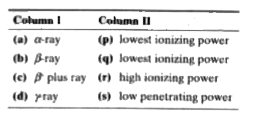Text Solution
Verified by Experts
The correct Answer is:
Topper's Solved these Questions
THE NUCLEUS
RESNICK AND HALLIDAY|Exercise PRACTICE QUESTIONS(Integer Type)|7 VideosTHE NUCLEUS
RESNICK AND HALLIDAY|Exercise PRACTICE QUESTIONS (Linked Comprehension)|12 VideosTHE KINETIC THEORY OF GASES
RESNICK AND HALLIDAY|Exercise PRACTICE QUESTIONS|72 VideosUNITS AND MEASUREMENT
RESNICK AND HALLIDAY|Exercise PRACTICE QUESTIONS (MATRIX-MATCH)|11 Videos
Similar Questions
Explore conceptually related problems
RESNICK AND HALLIDAY-THE NUCLEUS-PRACTICE QUESTIONS(Matrix - Match)
- Match the statements in Column I labelled as a,b,c, and d with those i...
Text Solution
|
- Symbol Q stands for energy released
Text Solution
|
- In each question, there is a table having 3 columns and 4 rows. Based ...
Text Solution
|
- In each question, there is a table having 3 columns and 4 rows. Based ...
Text Solution
|
- In each question, there is a table having 3 columns and 4 rows. Based ...
Text Solution
|
- In the given table, column I shows the different types of decays in nu...
Text Solution
|
- In the given table, column I shows the different types of decays in nu...
Text Solution
|
- In the given table, column I shows the different types of decays in nu...
Text Solution
|
- There are different types of radioactive series that radioactivie deca...
Text Solution
|
- There are different types of radioactive series that radioactivie deca...
Text Solution
|
- There are different types of radioactive series that radioactivie deca...
Text Solution
|
- Many side particles are produced when radioactive decay takes place.In...
Text Solution
|
- Many side particles are produced when radioactive decay takes place.In...
Text Solution
|
- Many side particles are produced when radioactive decay takes place.In...
Text Solution
|
